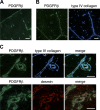Localization of mesenchymal cells in adult mouse thymus: their abnormal distribution in mice with disorganization of thymic medullary epithelium
- PMID: 19110482
- PMCID: PMC2664980
- DOI: 10.1369/jhc.2008.952895
Localization of mesenchymal cells in adult mouse thymus: their abnormal distribution in mice with disorganization of thymic medullary epithelium
Abstract
Thymic mesenchymal cells are known to be important for the development of the early fetal thymus into a functionally mature organ supporting T cell differentiation. We examined the expression of mesenchymal markers: pan-mesenchymal marker ER-TR7, desmin, alpha-smooth muscle actin (alpha-SMA), and alpha- and beta-chain of platelet-derived growth factor receptor (PDGFRalpha, PDGFRbeta) in thymi of normal adult mice. Desmin and ER-TR7 revealed specific staining in the capsule, septa, and perivascular cells. Most perivascular cells highly expressed PDGFRbeta at the same levels as desmin. Low expression of PDGFRalpha was detected in the capsule, intralobular septa, and some perivascular cells of normal adult thymi. alpha-SMA, used to identify vascular smooth muscle cells, was detectable on arterioles and some large venules but not on capillaries. Thus, desmin, PDGFRalpha, and PDGFRbeta were localized in the capsule, septa, and perivascular cells in thymus of adult mouse, although there were differences in the expression level among these markers. On the other hand, the expression of mesenchymal markers was detectable in the region of the thymic medullary epithelium of lymphotoxin beta receptor-deficient mice and plt/plt mice, indicating that mesenchymal cells were abnormally localized in the region. These results suggest that disorganization of the medullary epithelium may be accompanied by aberrant distribution of mesenchyme in adult mouse thymus.
Figures







References
-
- Bockman DE, Kirby ML (1984) Dependence of thymus development on derivatives of the neural crest. Science 223:498–500 - PubMed
-
- Bondjers C, He L, Takemoto M, Norlin J, Asker N, Hellström M, Lindahl P, et al. (2006) Microarray analysis of blood microvessels from PDGF-B and PDGF-Rbeta mutant mice identifies novel markers for brain pericytes. FASEB J 20:1703–1705 - PubMed
MeSH terms
Substances
LinkOut - more resources
Full Text Sources
Other Literature Sources
Molecular Biology Databases

